Impact of Change on Organizational Strategies: Unilever & P&G Report
VerifiedAdded on 2020/06/06
|12
|3798
|75
Report
AI Summary
This report examines change management strategies within Unilever and Procter & Gamble, focusing on the impact of change on organizational strategies and operations. It explores how internal and external drivers, such as political, economic, social, and technological factors, influence leadership styles and team behaviors. The report analyzes the strengths, weaknesses, opportunities, and threats (SWOT) and political, economic, social, and technological (PEST) factors affecting these organizations. It also discusses measures to minimize the negative impacts of change, including employee involvement, effective communication, training, and feedback. Furthermore, the report identifies various barriers to change, such as resistance from employees and unknown current states, and their influence on leadership decision-making. Finally, it outlines different leadership approaches to effectively manage and implement change within the organizations.
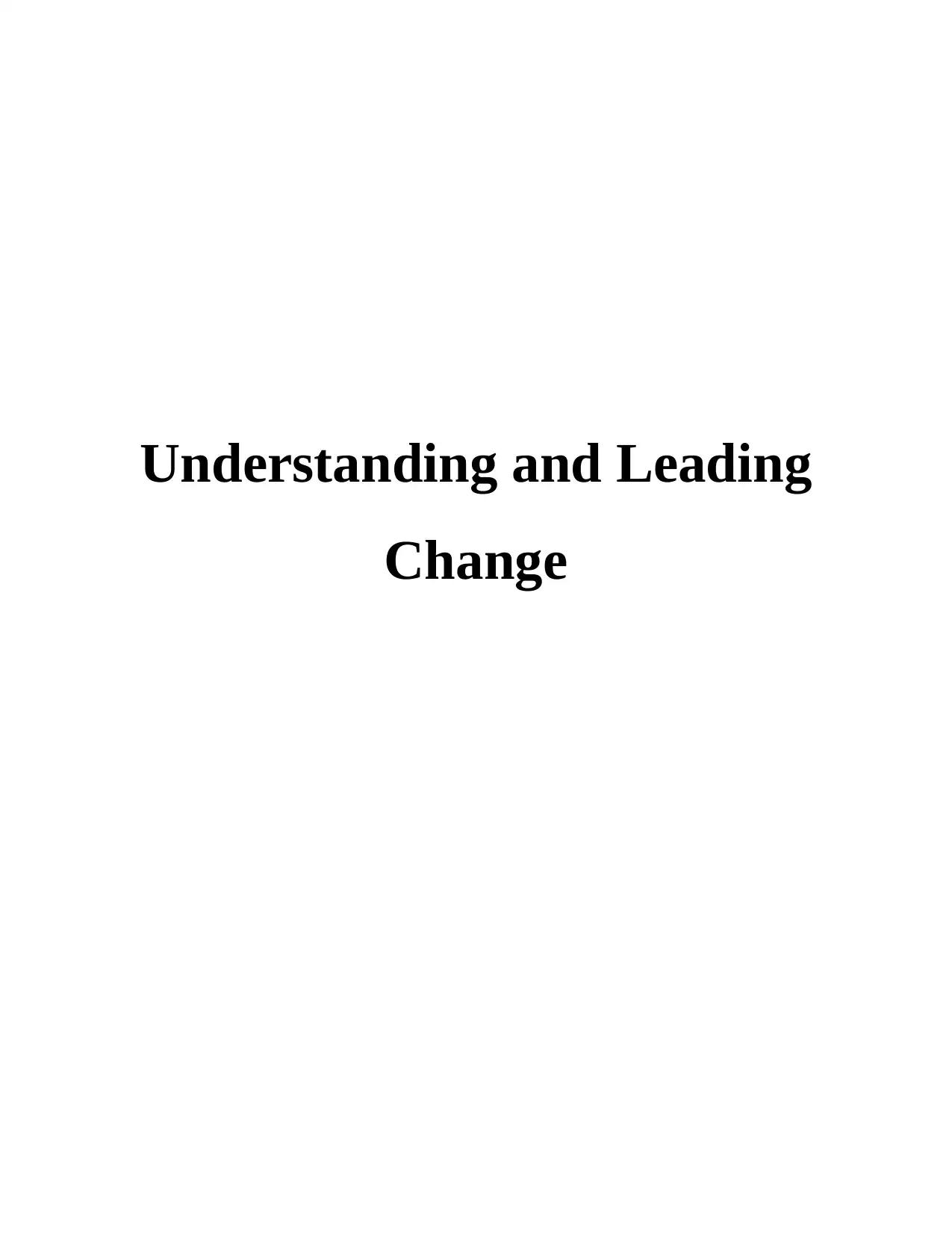
Understanding and Leading
Change
Change
Paraphrase This Document
Need a fresh take? Get an instant paraphrase of this document with our AI Paraphraser
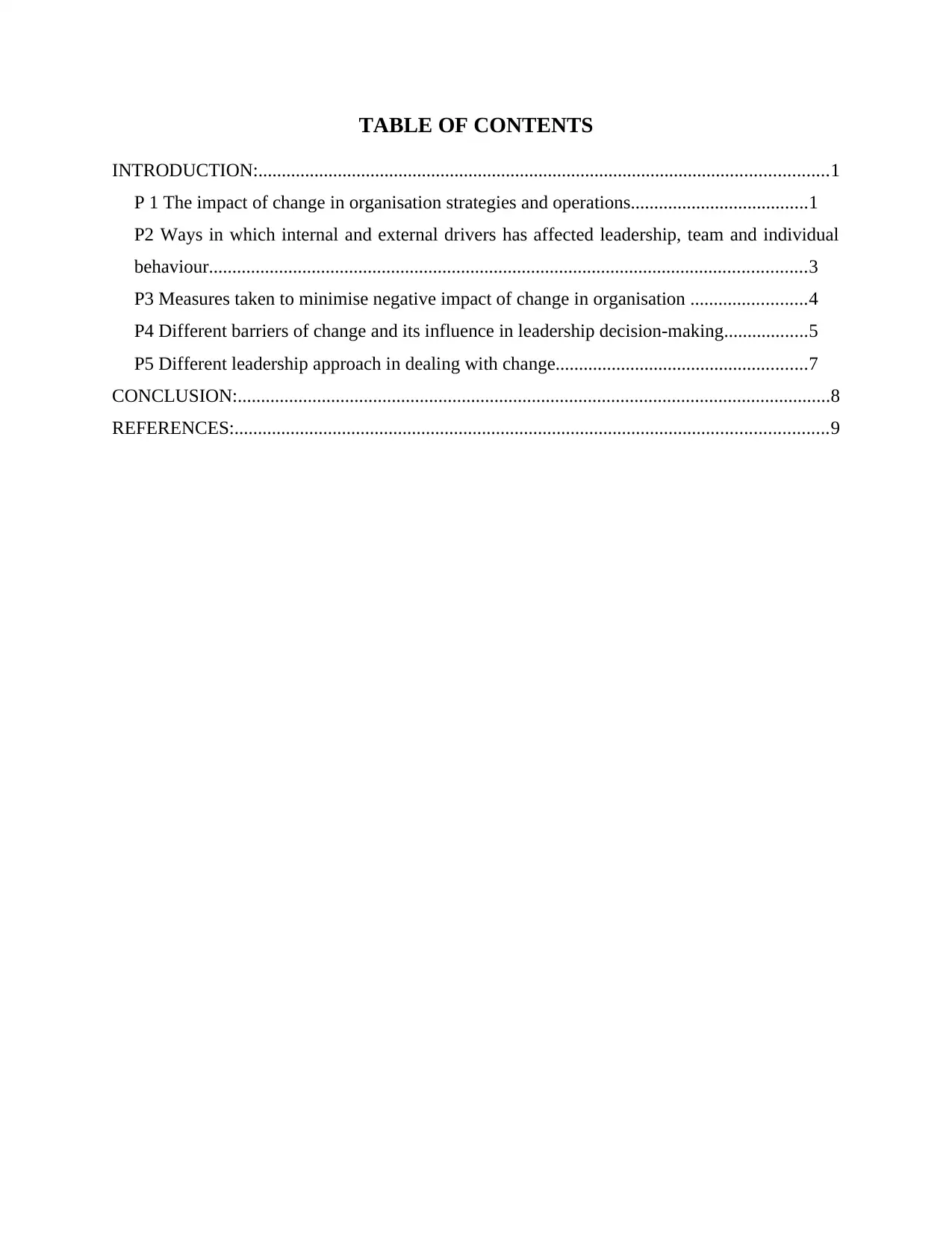
TABLE OF CONTENTS
INTRODUCTION:..........................................................................................................................1
P 1 The impact of change in organisation strategies and operations......................................1
P2 Ways in which internal and external drivers has affected leadership, team and individual
behaviour................................................................................................................................3
P3 Measures taken to minimise negative impact of change in organisation .........................4
P4 Different barriers of change and its influence in leadership decision-making..................5
P5 Different leadership approach in dealing with change......................................................7
CONCLUSION:...............................................................................................................................8
REFERENCES:...............................................................................................................................9
INTRODUCTION:..........................................................................................................................1
P 1 The impact of change in organisation strategies and operations......................................1
P2 Ways in which internal and external drivers has affected leadership, team and individual
behaviour................................................................................................................................3
P3 Measures taken to minimise negative impact of change in organisation .........................4
P4 Different barriers of change and its influence in leadership decision-making..................5
P5 Different leadership approach in dealing with change......................................................7
CONCLUSION:...............................................................................................................................8
REFERENCES:...............................................................................................................................9
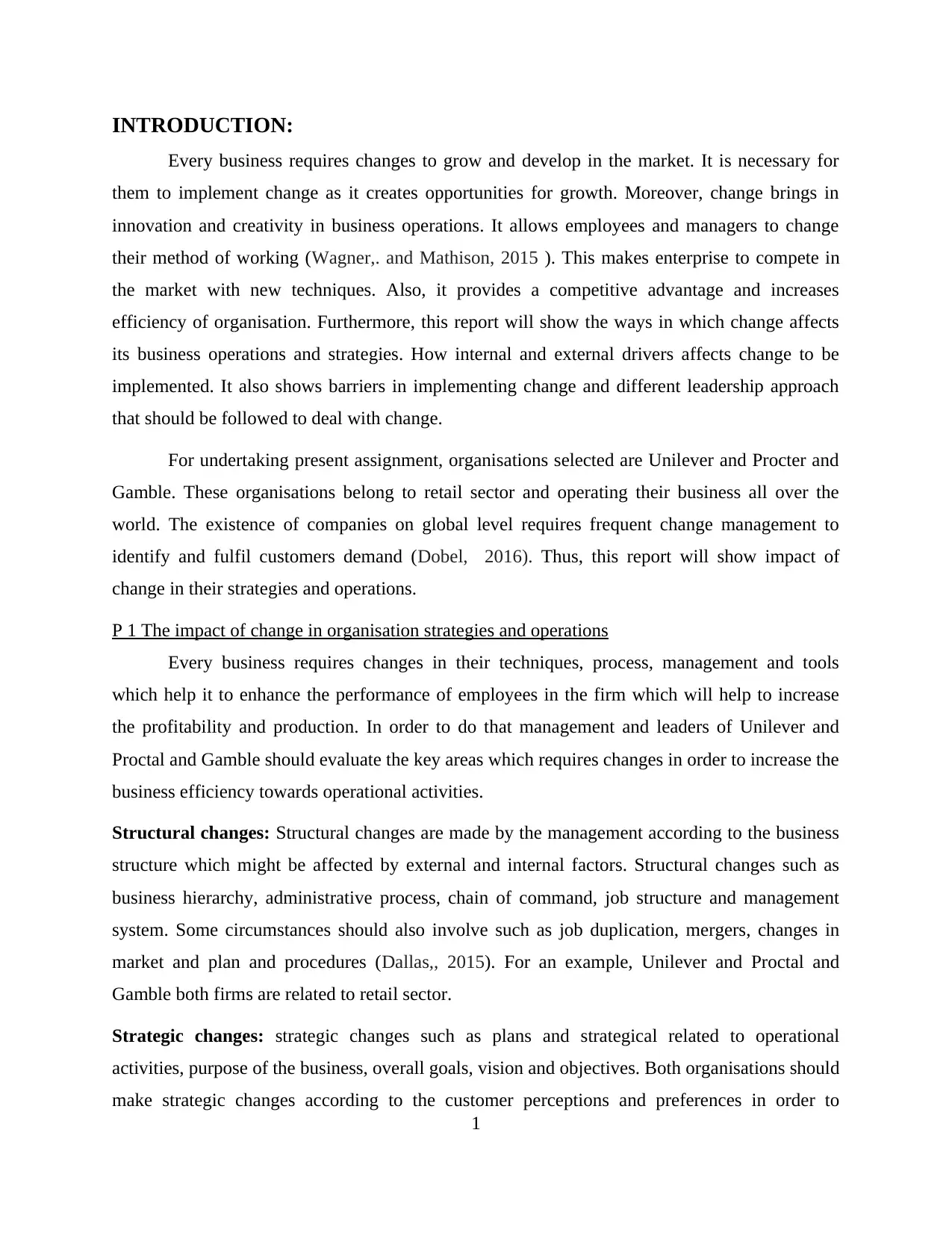
INTRODUCTION:
Every business requires changes to grow and develop in the market. It is necessary for
them to implement change as it creates opportunities for growth. Moreover, change brings in
innovation and creativity in business operations. It allows employees and managers to change
their method of working (Wagner,. and Mathison, 2015 ). This makes enterprise to compete in
the market with new techniques. Also, it provides a competitive advantage and increases
efficiency of organisation. Furthermore, this report will show the ways in which change affects
its business operations and strategies. How internal and external drivers affects change to be
implemented. It also shows barriers in implementing change and different leadership approach
that should be followed to deal with change.
For undertaking present assignment, organisations selected are Unilever and Procter and
Gamble. These organisations belong to retail sector and operating their business all over the
world. The existence of companies on global level requires frequent change management to
identify and fulfil customers demand (Dobel, 2016). Thus, this report will show impact of
change in their strategies and operations.
P 1 The impact of change in organisation strategies and operations
Every business requires changes in their techniques, process, management and tools
which help it to enhance the performance of employees in the firm which will help to increase
the profitability and production. In order to do that management and leaders of Unilever and
Proctal and Gamble should evaluate the key areas which requires changes in order to increase the
business efficiency towards operational activities.
Structural changes: Structural changes are made by the management according to the business
structure which might be affected by external and internal factors. Structural changes such as
business hierarchy, administrative process, chain of command, job structure and management
system. Some circumstances should also involve such as job duplication, mergers, changes in
market and plan and procedures (Dallas,, 2015). For an example, Unilever and Proctal and
Gamble both firms are related to retail sector.
Strategic changes: strategic changes such as plans and strategical related to operational
activities, purpose of the business, overall goals, vision and objectives. Both organisations should
make strategic changes according to the customer perceptions and preferences in order to
1
Every business requires changes to grow and develop in the market. It is necessary for
them to implement change as it creates opportunities for growth. Moreover, change brings in
innovation and creativity in business operations. It allows employees and managers to change
their method of working (Wagner,. and Mathison, 2015 ). This makes enterprise to compete in
the market with new techniques. Also, it provides a competitive advantage and increases
efficiency of organisation. Furthermore, this report will show the ways in which change affects
its business operations and strategies. How internal and external drivers affects change to be
implemented. It also shows barriers in implementing change and different leadership approach
that should be followed to deal with change.
For undertaking present assignment, organisations selected are Unilever and Procter and
Gamble. These organisations belong to retail sector and operating their business all over the
world. The existence of companies on global level requires frequent change management to
identify and fulfil customers demand (Dobel, 2016). Thus, this report will show impact of
change in their strategies and operations.
P 1 The impact of change in organisation strategies and operations
Every business requires changes in their techniques, process, management and tools
which help it to enhance the performance of employees in the firm which will help to increase
the profitability and production. In order to do that management and leaders of Unilever and
Proctal and Gamble should evaluate the key areas which requires changes in order to increase the
business efficiency towards operational activities.
Structural changes: Structural changes are made by the management according to the business
structure which might be affected by external and internal factors. Structural changes such as
business hierarchy, administrative process, chain of command, job structure and management
system. Some circumstances should also involve such as job duplication, mergers, changes in
market and plan and procedures (Dallas,, 2015). For an example, Unilever and Proctal and
Gamble both firms are related to retail sector.
Strategic changes: strategic changes such as plans and strategical related to operational
activities, purpose of the business, overall goals, vision and objectives. Both organisations should
make strategic changes according to the customer perceptions and preferences in order to
1
⊘ This is a preview!⊘
Do you want full access?
Subscribe today to unlock all pages.

Trusted by 1+ million students worldwide
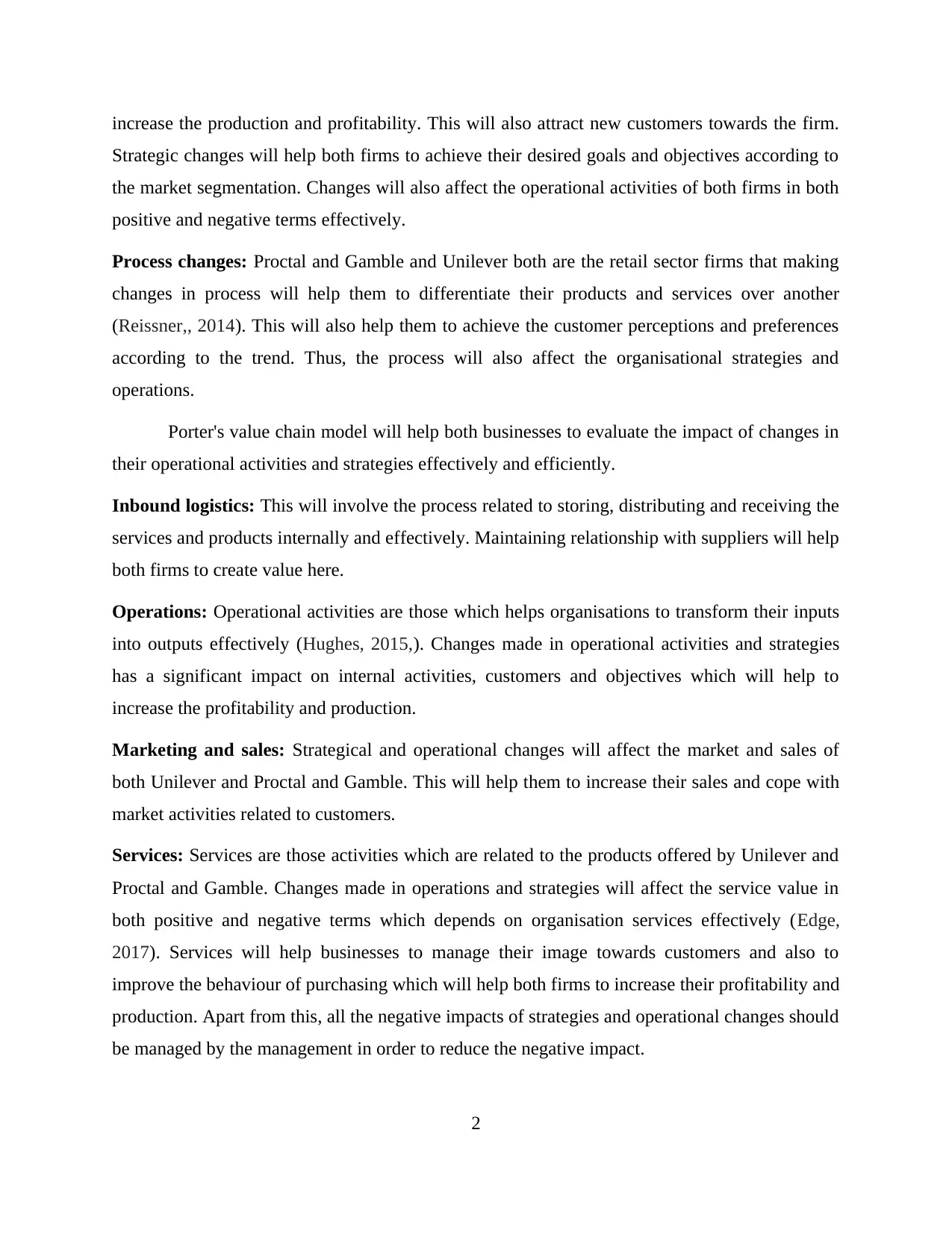
increase the production and profitability. This will also attract new customers towards the firm.
Strategic changes will help both firms to achieve their desired goals and objectives according to
the market segmentation. Changes will also affect the operational activities of both firms in both
positive and negative terms effectively.
Process changes: Proctal and Gamble and Unilever both are the retail sector firms that making
changes in process will help them to differentiate their products and services over another
(Reissner,, 2014). This will also help them to achieve the customer perceptions and preferences
according to the trend. Thus, the process will also affect the organisational strategies and
operations.
Porter's value chain model will help both businesses to evaluate the impact of changes in
their operational activities and strategies effectively and efficiently.
Inbound logistics: This will involve the process related to storing, distributing and receiving the
services and products internally and effectively. Maintaining relationship with suppliers will help
both firms to create value here.
Operations: Operational activities are those which helps organisations to transform their inputs
into outputs effectively (Hughes, 2015,). Changes made in operational activities and strategies
has a significant impact on internal activities, customers and objectives which will help to
increase the profitability and production.
Marketing and sales: Strategical and operational changes will affect the market and sales of
both Unilever and Proctal and Gamble. This will help them to increase their sales and cope with
market activities related to customers.
Services: Services are those activities which are related to the products offered by Unilever and
Proctal and Gamble. Changes made in operations and strategies will affect the service value in
both positive and negative terms which depends on organisation services effectively (Edge,
2017). Services will help businesses to manage their image towards customers and also to
improve the behaviour of purchasing which will help both firms to increase their profitability and
production. Apart from this, all the negative impacts of strategies and operational changes should
be managed by the management in order to reduce the negative impact.
2
Strategic changes will help both firms to achieve their desired goals and objectives according to
the market segmentation. Changes will also affect the operational activities of both firms in both
positive and negative terms effectively.
Process changes: Proctal and Gamble and Unilever both are the retail sector firms that making
changes in process will help them to differentiate their products and services over another
(Reissner,, 2014). This will also help them to achieve the customer perceptions and preferences
according to the trend. Thus, the process will also affect the organisational strategies and
operations.
Porter's value chain model will help both businesses to evaluate the impact of changes in
their operational activities and strategies effectively and efficiently.
Inbound logistics: This will involve the process related to storing, distributing and receiving the
services and products internally and effectively. Maintaining relationship with suppliers will help
both firms to create value here.
Operations: Operational activities are those which helps organisations to transform their inputs
into outputs effectively (Hughes, 2015,). Changes made in operational activities and strategies
has a significant impact on internal activities, customers and objectives which will help to
increase the profitability and production.
Marketing and sales: Strategical and operational changes will affect the market and sales of
both Unilever and Proctal and Gamble. This will help them to increase their sales and cope with
market activities related to customers.
Services: Services are those activities which are related to the products offered by Unilever and
Proctal and Gamble. Changes made in operations and strategies will affect the service value in
both positive and negative terms which depends on organisation services effectively (Edge,
2017). Services will help businesses to manage their image towards customers and also to
improve the behaviour of purchasing which will help both firms to increase their profitability and
production. Apart from this, all the negative impacts of strategies and operational changes should
be managed by the management in order to reduce the negative impact.
2
Paraphrase This Document
Need a fresh take? Get an instant paraphrase of this document with our AI Paraphraser
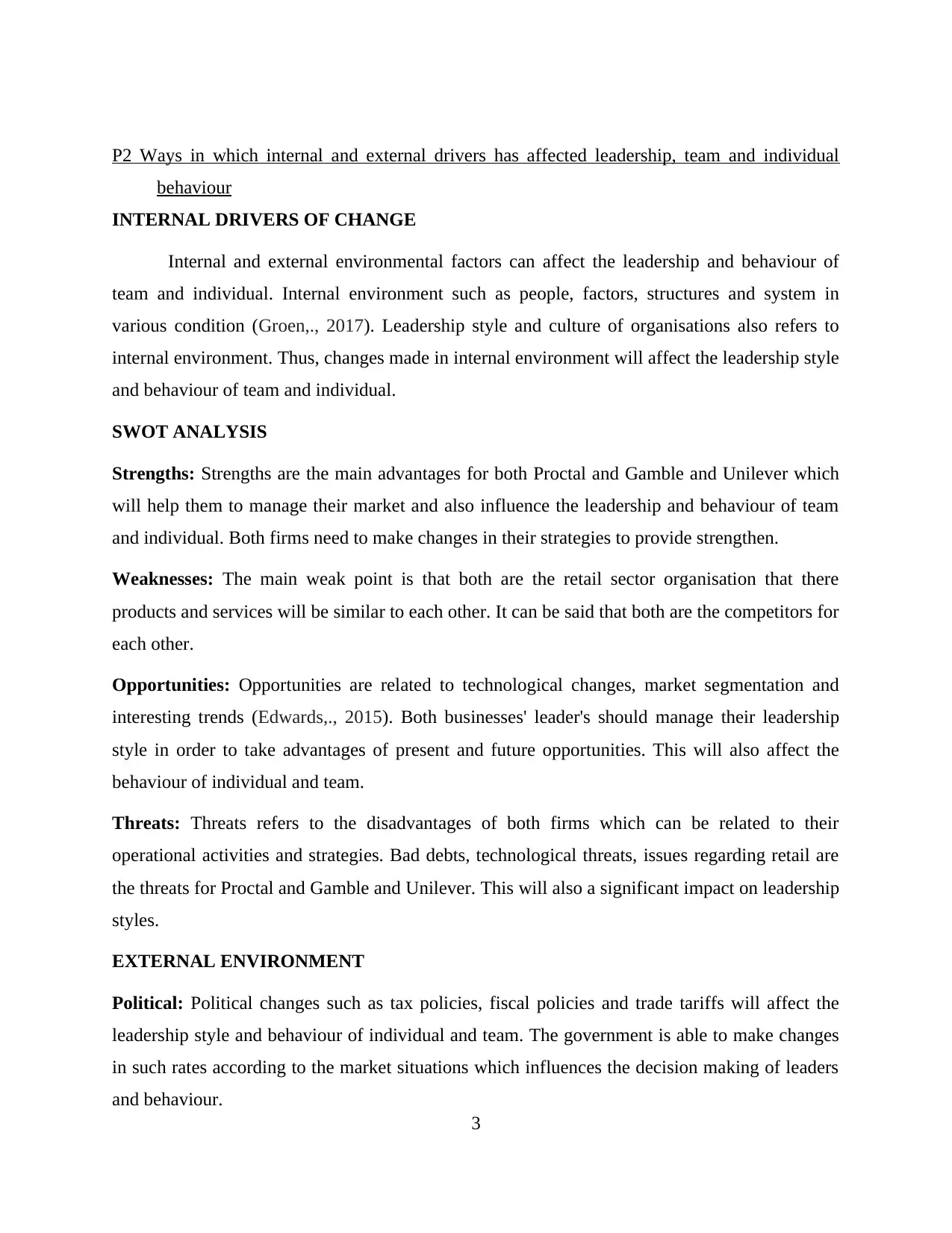
P2 Ways in which internal and external drivers has affected leadership, team and individual
behaviour
INTERNAL DRIVERS OF CHANGE
Internal and external environmental factors can affect the leadership and behaviour of
team and individual. Internal environment such as people, factors, structures and system in
various condition (Groen,., 2017). Leadership style and culture of organisations also refers to
internal environment. Thus, changes made in internal environment will affect the leadership style
and behaviour of team and individual.
SWOT ANALYSIS
Strengths: Strengths are the main advantages for both Proctal and Gamble and Unilever which
will help them to manage their market and also influence the leadership and behaviour of team
and individual. Both firms need to make changes in their strategies to provide strengthen.
Weaknesses: The main weak point is that both are the retail sector organisation that there
products and services will be similar to each other. It can be said that both are the competitors for
each other.
Opportunities: Opportunities are related to technological changes, market segmentation and
interesting trends (Edwards,., 2015). Both businesses' leader's should manage their leadership
style in order to take advantages of present and future opportunities. This will also affect the
behaviour of individual and team.
Threats: Threats refers to the disadvantages of both firms which can be related to their
operational activities and strategies. Bad debts, technological threats, issues regarding retail are
the threats for Proctal and Gamble and Unilever. This will also a significant impact on leadership
styles.
EXTERNAL ENVIRONMENT
Political: Political changes such as tax policies, fiscal policies and trade tariffs will affect the
leadership style and behaviour of individual and team. The government is able to make changes
in such rates according to the market situations which influences the decision making of leaders
and behaviour.
3
behaviour
INTERNAL DRIVERS OF CHANGE
Internal and external environmental factors can affect the leadership and behaviour of
team and individual. Internal environment such as people, factors, structures and system in
various condition (Groen,., 2017). Leadership style and culture of organisations also refers to
internal environment. Thus, changes made in internal environment will affect the leadership style
and behaviour of team and individual.
SWOT ANALYSIS
Strengths: Strengths are the main advantages for both Proctal and Gamble and Unilever which
will help them to manage their market and also influence the leadership and behaviour of team
and individual. Both firms need to make changes in their strategies to provide strengthen.
Weaknesses: The main weak point is that both are the retail sector organisation that there
products and services will be similar to each other. It can be said that both are the competitors for
each other.
Opportunities: Opportunities are related to technological changes, market segmentation and
interesting trends (Edwards,., 2015). Both businesses' leader's should manage their leadership
style in order to take advantages of present and future opportunities. This will also affect the
behaviour of individual and team.
Threats: Threats refers to the disadvantages of both firms which can be related to their
operational activities and strategies. Bad debts, technological threats, issues regarding retail are
the threats for Proctal and Gamble and Unilever. This will also a significant impact on leadership
styles.
EXTERNAL ENVIRONMENT
Political: Political changes such as tax policies, fiscal policies and trade tariffs will affect the
leadership style and behaviour of individual and team. The government is able to make changes
in such rates according to the market situations which influences the decision making of leaders
and behaviour.
3
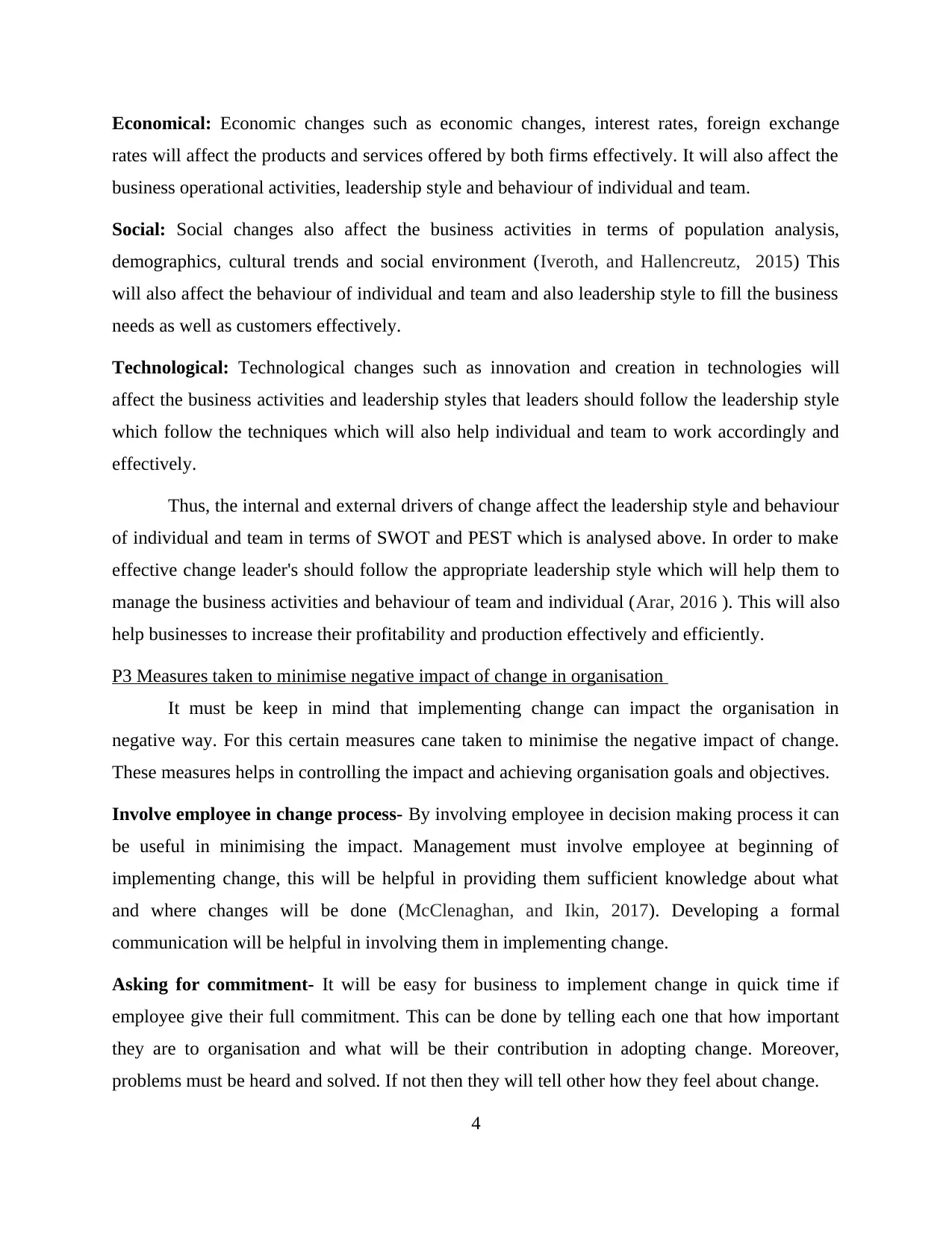
Economical: Economic changes such as economic changes, interest rates, foreign exchange
rates will affect the products and services offered by both firms effectively. It will also affect the
business operational activities, leadership style and behaviour of individual and team.
Social: Social changes also affect the business activities in terms of population analysis,
demographics, cultural trends and social environment (Iveroth, and Hallencreutz, 2015) This
will also affect the behaviour of individual and team and also leadership style to fill the business
needs as well as customers effectively.
Technological: Technological changes such as innovation and creation in technologies will
affect the business activities and leadership styles that leaders should follow the leadership style
which follow the techniques which will also help individual and team to work accordingly and
effectively.
Thus, the internal and external drivers of change affect the leadership style and behaviour
of individual and team in terms of SWOT and PEST which is analysed above. In order to make
effective change leader's should follow the appropriate leadership style which will help them to
manage the business activities and behaviour of team and individual (Arar, 2016 ). This will also
help businesses to increase their profitability and production effectively and efficiently.
P3 Measures taken to minimise negative impact of change in organisation
It must be keep in mind that implementing change can impact the organisation in
negative way. For this certain measures cane taken to minimise the negative impact of change.
These measures helps in controlling the impact and achieving organisation goals and objectives.
Involve employee in change process- By involving employee in decision making process it can
be useful in minimising the impact. Management must involve employee at beginning of
implementing change, this will be helpful in providing them sufficient knowledge about what
and where changes will be done (McClenaghan, and Ikin, 2017). Developing a formal
communication will be helpful in involving them in implementing change.
Asking for commitment- It will be easy for business to implement change in quick time if
employee give their full commitment. This can be done by telling each one that how important
they are to organisation and what will be their contribution in adopting change. Moreover,
problems must be heard and solved. If not then they will tell other how they feel about change.
4
rates will affect the products and services offered by both firms effectively. It will also affect the
business operational activities, leadership style and behaviour of individual and team.
Social: Social changes also affect the business activities in terms of population analysis,
demographics, cultural trends and social environment (Iveroth, and Hallencreutz, 2015) This
will also affect the behaviour of individual and team and also leadership style to fill the business
needs as well as customers effectively.
Technological: Technological changes such as innovation and creation in technologies will
affect the business activities and leadership styles that leaders should follow the leadership style
which follow the techniques which will also help individual and team to work accordingly and
effectively.
Thus, the internal and external drivers of change affect the leadership style and behaviour
of individual and team in terms of SWOT and PEST which is analysed above. In order to make
effective change leader's should follow the appropriate leadership style which will help them to
manage the business activities and behaviour of team and individual (Arar, 2016 ). This will also
help businesses to increase their profitability and production effectively and efficiently.
P3 Measures taken to minimise negative impact of change in organisation
It must be keep in mind that implementing change can impact the organisation in
negative way. For this certain measures cane taken to minimise the negative impact of change.
These measures helps in controlling the impact and achieving organisation goals and objectives.
Involve employee in change process- By involving employee in decision making process it can
be useful in minimising the impact. Management must involve employee at beginning of
implementing change, this will be helpful in providing them sufficient knowledge about what
and where changes will be done (McClenaghan, and Ikin, 2017). Developing a formal
communication will be helpful in involving them in implementing change.
Asking for commitment- It will be easy for business to implement change in quick time if
employee give their full commitment. This can be done by telling each one that how important
they are to organisation and what will be their contribution in adopting change. Moreover,
problems must be heard and solved. If not then they will tell other how they feel about change.
4
⊘ This is a preview!⊘
Do you want full access?
Subscribe today to unlock all pages.

Trusted by 1+ million students worldwide
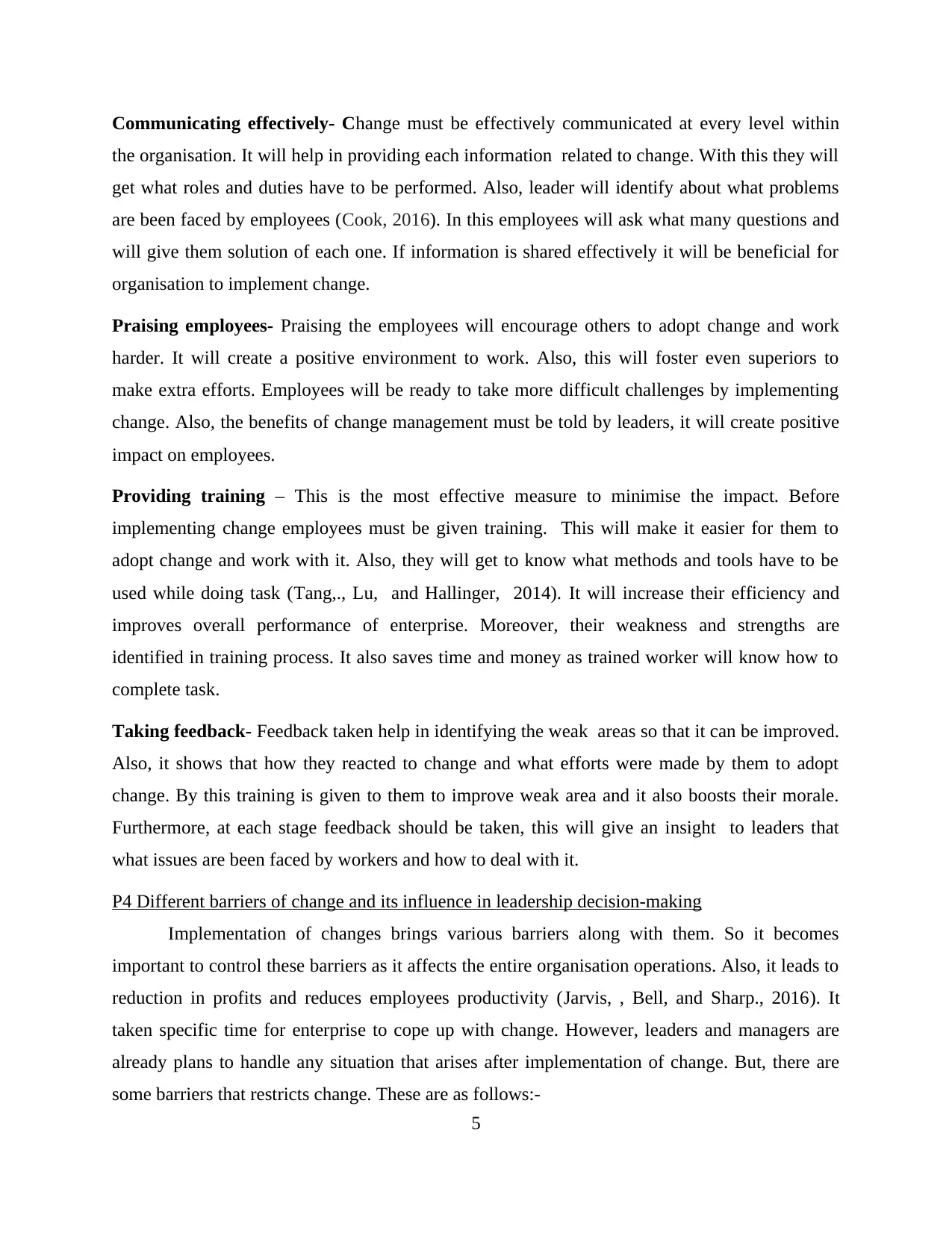
Communicating effectively- Change must be effectively communicated at every level within
the organisation. It will help in providing each information related to change. With this they will
get what roles and duties have to be performed. Also, leader will identify about what problems
are been faced by employees (Cook, 2016). In this employees will ask what many questions and
will give them solution of each one. If information is shared effectively it will be beneficial for
organisation to implement change.
Praising employees- Praising the employees will encourage others to adopt change and work
harder. It will create a positive environment to work. Also, this will foster even superiors to
make extra efforts. Employees will be ready to take more difficult challenges by implementing
change. Also, the benefits of change management must be told by leaders, it will create positive
impact on employees.
Providing training – This is the most effective measure to minimise the impact. Before
implementing change employees must be given training. This will make it easier for them to
adopt change and work with it. Also, they will get to know what methods and tools have to be
used while doing task (Tang,., Lu, and Hallinger, 2014). It will increase their efficiency and
improves overall performance of enterprise. Moreover, their weakness and strengths are
identified in training process. It also saves time and money as trained worker will know how to
complete task.
Taking feedback- Feedback taken help in identifying the weak areas so that it can be improved.
Also, it shows that how they reacted to change and what efforts were made by them to adopt
change. By this training is given to them to improve weak area and it also boosts their morale.
Furthermore, at each stage feedback should be taken, this will give an insight to leaders that
what issues are been faced by workers and how to deal with it.
P4 Different barriers of change and its influence in leadership decision-making
Implementation of changes brings various barriers along with them. So it becomes
important to control these barriers as it affects the entire organisation operations. Also, it leads to
reduction in profits and reduces employees productivity (Jarvis, , Bell, and Sharp., 2016). It
taken specific time for enterprise to cope up with change. However, leaders and managers are
already plans to handle any situation that arises after implementation of change. But, there are
some barriers that restricts change. These are as follows:-
5
the organisation. It will help in providing each information related to change. With this they will
get what roles and duties have to be performed. Also, leader will identify about what problems
are been faced by employees (Cook, 2016). In this employees will ask what many questions and
will give them solution of each one. If information is shared effectively it will be beneficial for
organisation to implement change.
Praising employees- Praising the employees will encourage others to adopt change and work
harder. It will create a positive environment to work. Also, this will foster even superiors to
make extra efforts. Employees will be ready to take more difficult challenges by implementing
change. Also, the benefits of change management must be told by leaders, it will create positive
impact on employees.
Providing training – This is the most effective measure to minimise the impact. Before
implementing change employees must be given training. This will make it easier for them to
adopt change and work with it. Also, they will get to know what methods and tools have to be
used while doing task (Tang,., Lu, and Hallinger, 2014). It will increase their efficiency and
improves overall performance of enterprise. Moreover, their weakness and strengths are
identified in training process. It also saves time and money as trained worker will know how to
complete task.
Taking feedback- Feedback taken help in identifying the weak areas so that it can be improved.
Also, it shows that how they reacted to change and what efforts were made by them to adopt
change. By this training is given to them to improve weak area and it also boosts their morale.
Furthermore, at each stage feedback should be taken, this will give an insight to leaders that
what issues are been faced by workers and how to deal with it.
P4 Different barriers of change and its influence in leadership decision-making
Implementation of changes brings various barriers along with them. So it becomes
important to control these barriers as it affects the entire organisation operations. Also, it leads to
reduction in profits and reduces employees productivity (Jarvis, , Bell, and Sharp., 2016). It
taken specific time for enterprise to cope up with change. However, leaders and managers are
already plans to handle any situation that arises after implementation of change. But, there are
some barriers that restricts change. These are as follows:-
5
Paraphrase This Document
Need a fresh take? Get an instant paraphrase of this document with our AI Paraphraser
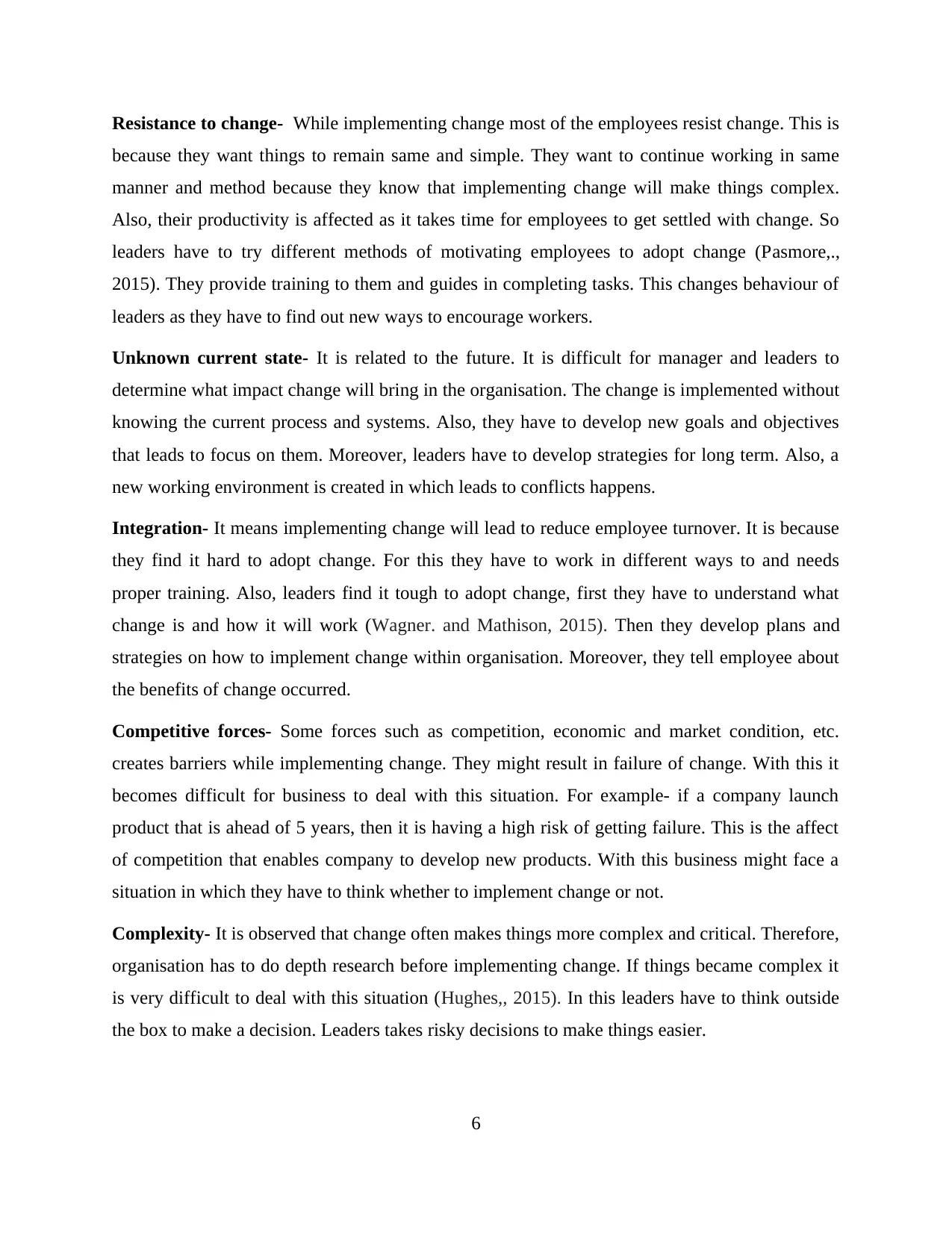
Resistance to change- While implementing change most of the employees resist change. This is
because they want things to remain same and simple. They want to continue working in same
manner and method because they know that implementing change will make things complex.
Also, their productivity is affected as it takes time for employees to get settled with change. So
leaders have to try different methods of motivating employees to adopt change (Pasmore,.,
2015). They provide training to them and guides in completing tasks. This changes behaviour of
leaders as they have to find out new ways to encourage workers.
Unknown current state- It is related to the future. It is difficult for manager and leaders to
determine what impact change will bring in the organisation. The change is implemented without
knowing the current process and systems. Also, they have to develop new goals and objectives
that leads to focus on them. Moreover, leaders have to develop strategies for long term. Also, a
new working environment is created in which leads to conflicts happens.
Integration- It means implementing change will lead to reduce employee turnover. It is because
they find it hard to adopt change. For this they have to work in different ways to and needs
proper training. Also, leaders find it tough to adopt change, first they have to understand what
change is and how it will work (Wagner. and Mathison, 2015). Then they develop plans and
strategies on how to implement change within organisation. Moreover, they tell employee about
the benefits of change occurred.
Competitive forces- Some forces such as competition, economic and market condition, etc.
creates barriers while implementing change. They might result in failure of change. With this it
becomes difficult for business to deal with this situation. For example- if a company launch
product that is ahead of 5 years, then it is having a high risk of getting failure. This is the affect
of competition that enables company to develop new products. With this business might face a
situation in which they have to think whether to implement change or not.
Complexity- It is observed that change often makes things more complex and critical. Therefore,
organisation has to do depth research before implementing change. If things became complex it
is very difficult to deal with this situation (Hughes,, 2015). In this leaders have to think outside
the box to make a decision. Leaders takes risky decisions to make things easier.
6
because they want things to remain same and simple. They want to continue working in same
manner and method because they know that implementing change will make things complex.
Also, their productivity is affected as it takes time for employees to get settled with change. So
leaders have to try different methods of motivating employees to adopt change (Pasmore,.,
2015). They provide training to them and guides in completing tasks. This changes behaviour of
leaders as they have to find out new ways to encourage workers.
Unknown current state- It is related to the future. It is difficult for manager and leaders to
determine what impact change will bring in the organisation. The change is implemented without
knowing the current process and systems. Also, they have to develop new goals and objectives
that leads to focus on them. Moreover, leaders have to develop strategies for long term. Also, a
new working environment is created in which leads to conflicts happens.
Integration- It means implementing change will lead to reduce employee turnover. It is because
they find it hard to adopt change. For this they have to work in different ways to and needs
proper training. Also, leaders find it tough to adopt change, first they have to understand what
change is and how it will work (Wagner. and Mathison, 2015). Then they develop plans and
strategies on how to implement change within organisation. Moreover, they tell employee about
the benefits of change occurred.
Competitive forces- Some forces such as competition, economic and market condition, etc.
creates barriers while implementing change. They might result in failure of change. With this it
becomes difficult for business to deal with this situation. For example- if a company launch
product that is ahead of 5 years, then it is having a high risk of getting failure. This is the affect
of competition that enables company to develop new products. With this business might face a
situation in which they have to think whether to implement change or not.
Complexity- It is observed that change often makes things more complex and critical. Therefore,
organisation has to do depth research before implementing change. If things became complex it
is very difficult to deal with this situation (Hughes,, 2015). In this leaders have to think outside
the box to make a decision. Leaders takes risky decisions to make things easier.
6
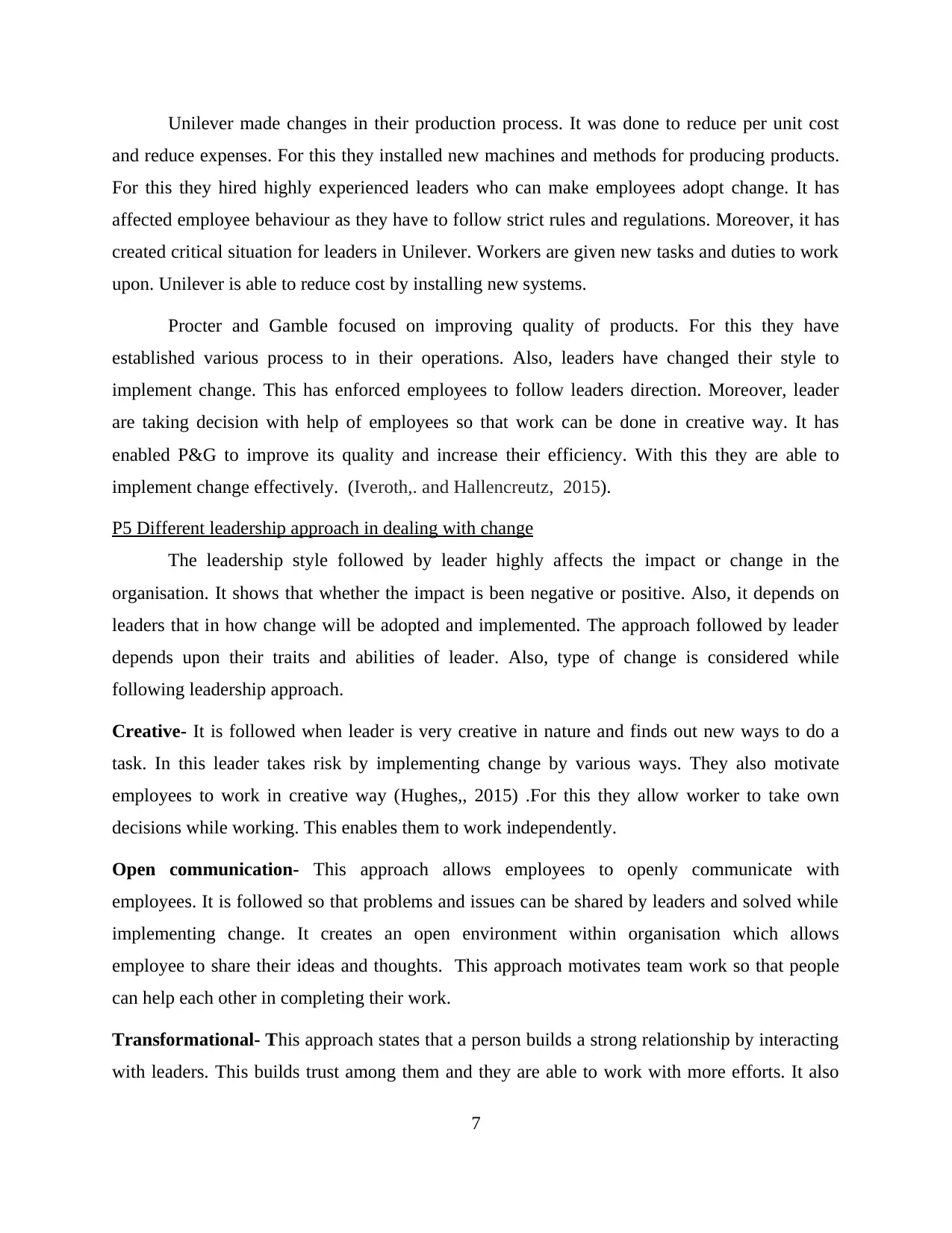
Unilever made changes in their production process. It was done to reduce per unit cost
and reduce expenses. For this they installed new machines and methods for producing products.
For this they hired highly experienced leaders who can make employees adopt change. It has
affected employee behaviour as they have to follow strict rules and regulations. Moreover, it has
created critical situation for leaders in Unilever. Workers are given new tasks and duties to work
upon. Unilever is able to reduce cost by installing new systems.
Procter and Gamble focused on improving quality of products. For this they have
established various process to in their operations. Also, leaders have changed their style to
implement change. This has enforced employees to follow leaders direction. Moreover, leader
are taking decision with help of employees so that work can be done in creative way. It has
enabled P&G to improve its quality and increase their efficiency. With this they are able to
implement change effectively. (Iveroth,. and Hallencreutz, 2015).
P5 Different leadership approach in dealing with change
The leadership style followed by leader highly affects the impact or change in the
organisation. It shows that whether the impact is been negative or positive. Also, it depends on
leaders that in how change will be adopted and implemented. The approach followed by leader
depends upon their traits and abilities of leader. Also, type of change is considered while
following leadership approach.
Creative- It is followed when leader is very creative in nature and finds out new ways to do a
task. In this leader takes risk by implementing change by various ways. They also motivate
employees to work in creative way (Hughes,, 2015) .For this they allow worker to take own
decisions while working. This enables them to work independently.
Open communication- This approach allows employees to openly communicate with
employees. It is followed so that problems and issues can be shared by leaders and solved while
implementing change. It creates an open environment within organisation which allows
employee to share their ideas and thoughts. This approach motivates team work so that people
can help each other in completing their work.
Transformational- This approach states that a person builds a strong relationship by interacting
with leaders. This builds trust among them and they are able to work with more efforts. It also
7
and reduce expenses. For this they installed new machines and methods for producing products.
For this they hired highly experienced leaders who can make employees adopt change. It has
affected employee behaviour as they have to follow strict rules and regulations. Moreover, it has
created critical situation for leaders in Unilever. Workers are given new tasks and duties to work
upon. Unilever is able to reduce cost by installing new systems.
Procter and Gamble focused on improving quality of products. For this they have
established various process to in their operations. Also, leaders have changed their style to
implement change. This has enforced employees to follow leaders direction. Moreover, leader
are taking decision with help of employees so that work can be done in creative way. It has
enabled P&G to improve its quality and increase their efficiency. With this they are able to
implement change effectively. (Iveroth,. and Hallencreutz, 2015).
P5 Different leadership approach in dealing with change
The leadership style followed by leader highly affects the impact or change in the
organisation. It shows that whether the impact is been negative or positive. Also, it depends on
leaders that in how change will be adopted and implemented. The approach followed by leader
depends upon their traits and abilities of leader. Also, type of change is considered while
following leadership approach.
Creative- It is followed when leader is very creative in nature and finds out new ways to do a
task. In this leader takes risk by implementing change by various ways. They also motivate
employees to work in creative way (Hughes,, 2015) .For this they allow worker to take own
decisions while working. This enables them to work independently.
Open communication- This approach allows employees to openly communicate with
employees. It is followed so that problems and issues can be shared by leaders and solved while
implementing change. It creates an open environment within organisation which allows
employee to share their ideas and thoughts. This approach motivates team work so that people
can help each other in completing their work.
Transformational- This approach states that a person builds a strong relationship by interacting
with leaders. This builds trust among them and they are able to work with more efforts. It also
7
⊘ This is a preview!⊘
Do you want full access?
Subscribe today to unlock all pages.

Trusted by 1+ million students worldwide
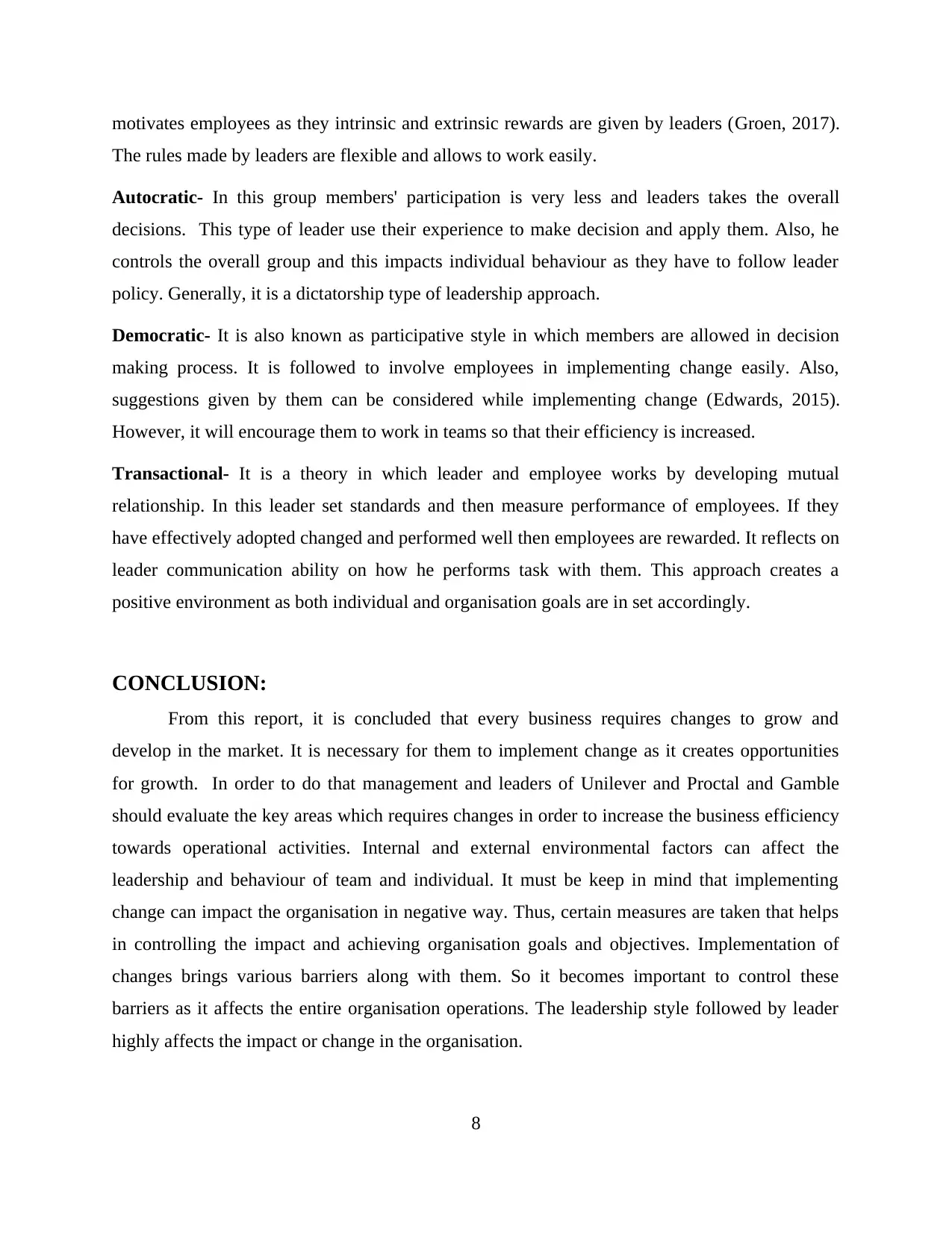
motivates employees as they intrinsic and extrinsic rewards are given by leaders (Groen, 2017).
The rules made by leaders are flexible and allows to work easily.
Autocratic- In this group members' participation is very less and leaders takes the overall
decisions. This type of leader use their experience to make decision and apply them. Also, he
controls the overall group and this impacts individual behaviour as they have to follow leader
policy. Generally, it is a dictatorship type of leadership approach.
Democratic- It is also known as participative style in which members are allowed in decision
making process. It is followed to involve employees in implementing change easily. Also,
suggestions given by them can be considered while implementing change (Edwards, 2015).
However, it will encourage them to work in teams so that their efficiency is increased.
Transactional- It is a theory in which leader and employee works by developing mutual
relationship. In this leader set standards and then measure performance of employees. If they
have effectively adopted changed and performed well then employees are rewarded. It reflects on
leader communication ability on how he performs task with them. This approach creates a
positive environment as both individual and organisation goals are in set accordingly.
CONCLUSION:
From this report, it is concluded that every business requires changes to grow and
develop in the market. It is necessary for them to implement change as it creates opportunities
for growth. In order to do that management and leaders of Unilever and Proctal and Gamble
should evaluate the key areas which requires changes in order to increase the business efficiency
towards operational activities. Internal and external environmental factors can affect the
leadership and behaviour of team and individual. It must be keep in mind that implementing
change can impact the organisation in negative way. Thus, certain measures are taken that helps
in controlling the impact and achieving organisation goals and objectives. Implementation of
changes brings various barriers along with them. So it becomes important to control these
barriers as it affects the entire organisation operations. The leadership style followed by leader
highly affects the impact or change in the organisation.
8
The rules made by leaders are flexible and allows to work easily.
Autocratic- In this group members' participation is very less and leaders takes the overall
decisions. This type of leader use their experience to make decision and apply them. Also, he
controls the overall group and this impacts individual behaviour as they have to follow leader
policy. Generally, it is a dictatorship type of leadership approach.
Democratic- It is also known as participative style in which members are allowed in decision
making process. It is followed to involve employees in implementing change easily. Also,
suggestions given by them can be considered while implementing change (Edwards, 2015).
However, it will encourage them to work in teams so that their efficiency is increased.
Transactional- It is a theory in which leader and employee works by developing mutual
relationship. In this leader set standards and then measure performance of employees. If they
have effectively adopted changed and performed well then employees are rewarded. It reflects on
leader communication ability on how he performs task with them. This approach creates a
positive environment as both individual and organisation goals are in set accordingly.
CONCLUSION:
From this report, it is concluded that every business requires changes to grow and
develop in the market. It is necessary for them to implement change as it creates opportunities
for growth. In order to do that management and leaders of Unilever and Proctal and Gamble
should evaluate the key areas which requires changes in order to increase the business efficiency
towards operational activities. Internal and external environmental factors can affect the
leadership and behaviour of team and individual. It must be keep in mind that implementing
change can impact the organisation in negative way. Thus, certain measures are taken that helps
in controlling the impact and achieving organisation goals and objectives. Implementation of
changes brings various barriers along with them. So it becomes important to control these
barriers as it affects the entire organisation operations. The leadership style followed by leader
highly affects the impact or change in the organisation.
8
Paraphrase This Document
Need a fresh take? Get an instant paraphrase of this document with our AI Paraphraser
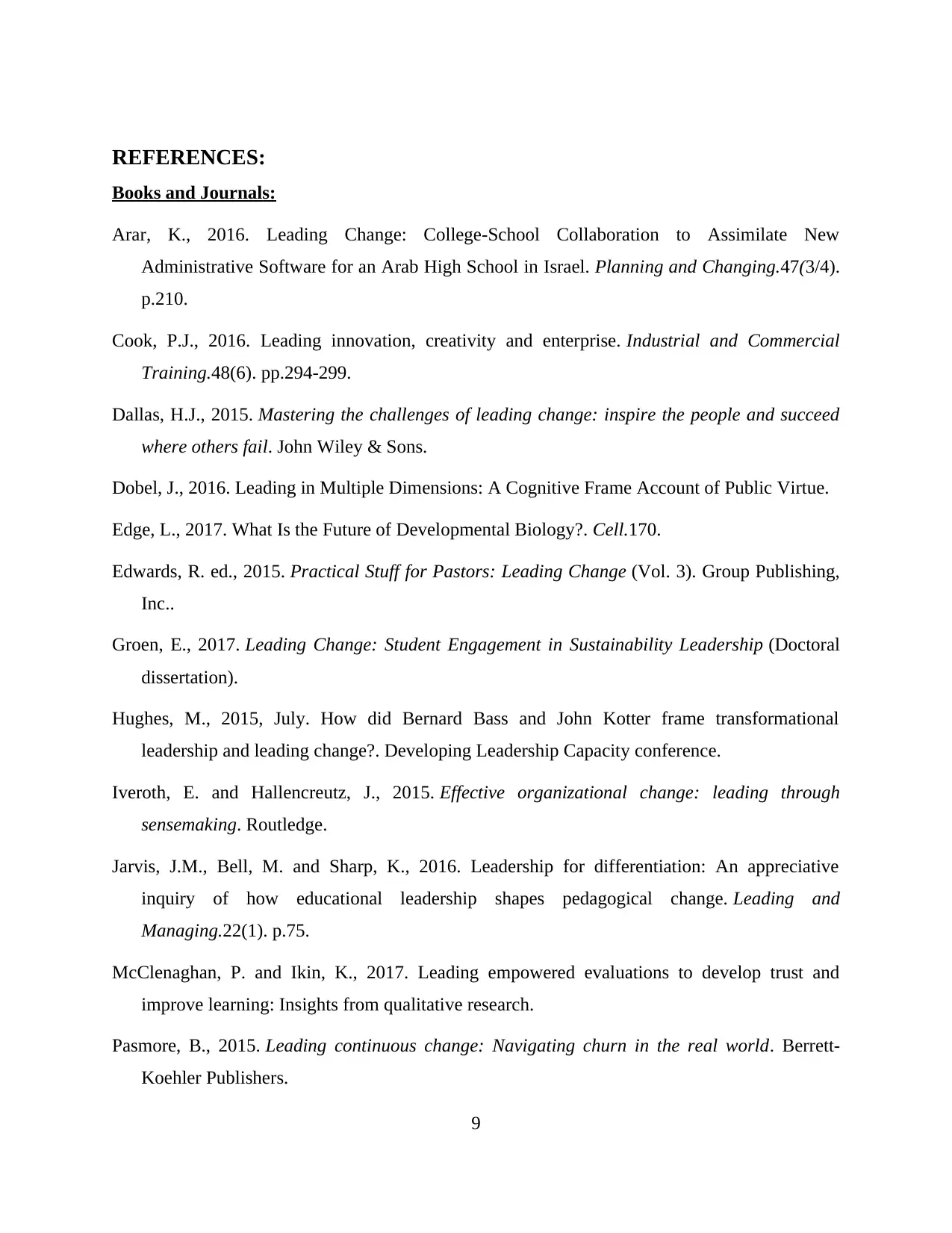
REFERENCES:
Books and Journals:
Arar, K., 2016. Leading Change: College-School Collaboration to Assimilate New
Administrative Software for an Arab High School in Israel. Planning and Changing.47(3/4).
p.210.
Cook, P.J., 2016. Leading innovation, creativity and enterprise. Industrial and Commercial
Training.48(6). pp.294-299.
Dallas, H.J., 2015. Mastering the challenges of leading change: inspire the people and succeed
where others fail. John Wiley & Sons.
Dobel, J., 2016. Leading in Multiple Dimensions: A Cognitive Frame Account of Public Virtue.
Edge, L., 2017. What Is the Future of Developmental Biology?. Cell.170.
Edwards, R. ed., 2015. Practical Stuff for Pastors: Leading Change (Vol. 3). Group Publishing,
Inc..
Groen, E., 2017. Leading Change: Student Engagement in Sustainability Leadership (Doctoral
dissertation).
Hughes, M., 2015, July. How did Bernard Bass and John Kotter frame transformational
leadership and leading change?. Developing Leadership Capacity conference.
Iveroth, E. and Hallencreutz, J., 2015. Effective organizational change: leading through
sensemaking. Routledge.
Jarvis, J.M., Bell, M. and Sharp, K., 2016. Leadership for differentiation: An appreciative
inquiry of how educational leadership shapes pedagogical change. Leading and
Managing.22(1). p.75.
McClenaghan, P. and Ikin, K., 2017. Leading empowered evaluations to develop trust and
improve learning: Insights from qualitative research.
Pasmore, B., 2015. Leading continuous change: Navigating churn in the real world. Berrett-
Koehler Publishers.
9
Books and Journals:
Arar, K., 2016. Leading Change: College-School Collaboration to Assimilate New
Administrative Software for an Arab High School in Israel. Planning and Changing.47(3/4).
p.210.
Cook, P.J., 2016. Leading innovation, creativity and enterprise. Industrial and Commercial
Training.48(6). pp.294-299.
Dallas, H.J., 2015. Mastering the challenges of leading change: inspire the people and succeed
where others fail. John Wiley & Sons.
Dobel, J., 2016. Leading in Multiple Dimensions: A Cognitive Frame Account of Public Virtue.
Edge, L., 2017. What Is the Future of Developmental Biology?. Cell.170.
Edwards, R. ed., 2015. Practical Stuff for Pastors: Leading Change (Vol. 3). Group Publishing,
Inc..
Groen, E., 2017. Leading Change: Student Engagement in Sustainability Leadership (Doctoral
dissertation).
Hughes, M., 2015, July. How did Bernard Bass and John Kotter frame transformational
leadership and leading change?. Developing Leadership Capacity conference.
Iveroth, E. and Hallencreutz, J., 2015. Effective organizational change: leading through
sensemaking. Routledge.
Jarvis, J.M., Bell, M. and Sharp, K., 2016. Leadership for differentiation: An appreciative
inquiry of how educational leadership shapes pedagogical change. Leading and
Managing.22(1). p.75.
McClenaghan, P. and Ikin, K., 2017. Leading empowered evaluations to develop trust and
improve learning: Insights from qualitative research.
Pasmore, B., 2015. Leading continuous change: Navigating churn in the real world. Berrett-
Koehler Publishers.
9
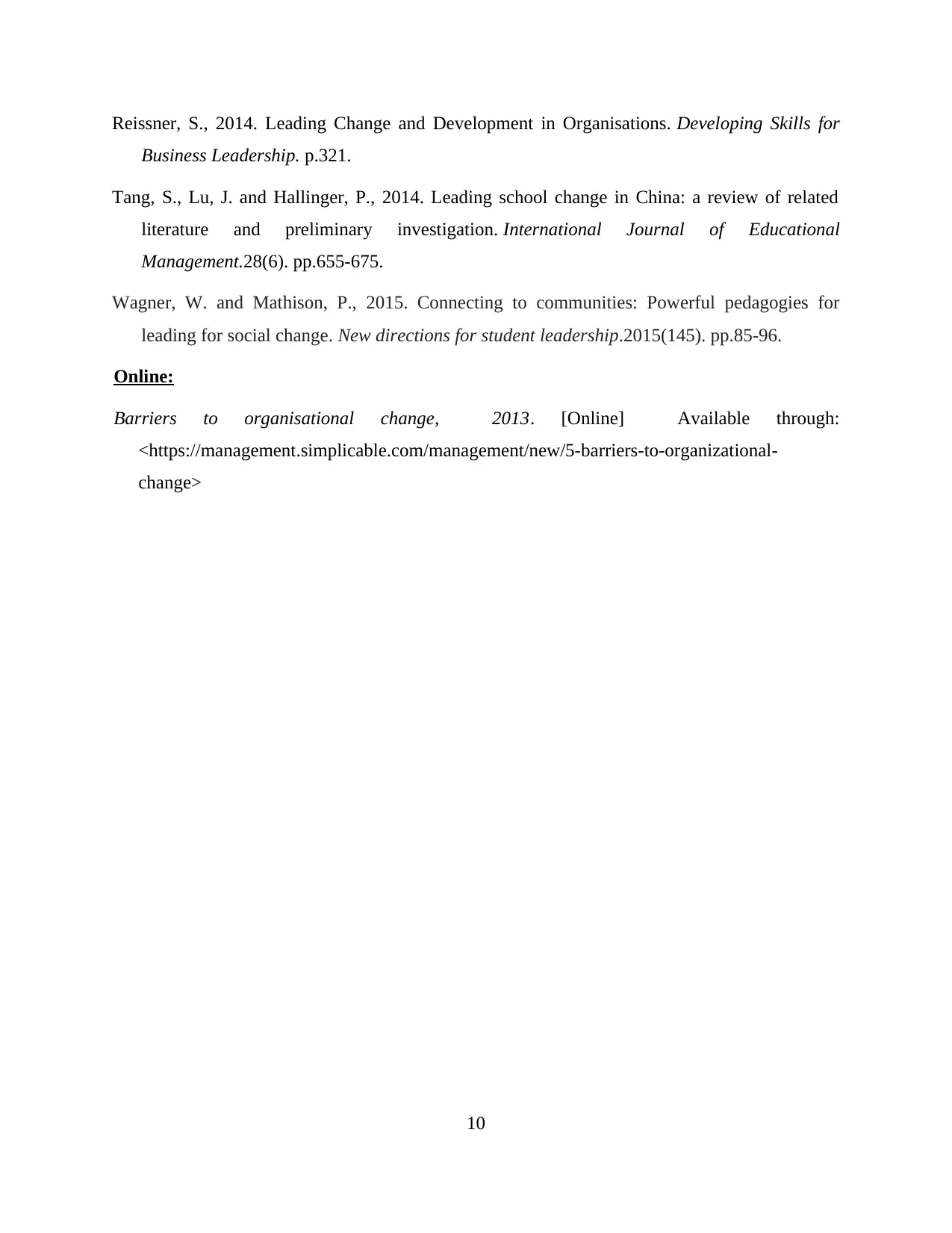
Reissner, S., 2014. Leading Change and Development in Organisations. Developing Skills for
Business Leadership. p.321.
Tang, S., Lu, J. and Hallinger, P., 2014. Leading school change in China: a review of related
literature and preliminary investigation. International Journal of Educational
Management.28(6). pp.655-675.
Wagner, W. and Mathison, P., 2015. Connecting to communities: Powerful pedagogies for
leading for social change. New directions for student leadership.2015(145). pp.85-96.
Online:
Barriers to organisational change, 2013. [Online] Available through:
<https://management.simplicable.com/management/new/5-barriers-to-organizational-
change>
10
Business Leadership. p.321.
Tang, S., Lu, J. and Hallinger, P., 2014. Leading school change in China: a review of related
literature and preliminary investigation. International Journal of Educational
Management.28(6). pp.655-675.
Wagner, W. and Mathison, P., 2015. Connecting to communities: Powerful pedagogies for
leading for social change. New directions for student leadership.2015(145). pp.85-96.
Online:
Barriers to organisational change, 2013. [Online] Available through:
<https://management.simplicable.com/management/new/5-barriers-to-organizational-
change>
10
⊘ This is a preview!⊘
Do you want full access?
Subscribe today to unlock all pages.

Trusted by 1+ million students worldwide
1 out of 12
Related Documents
Your All-in-One AI-Powered Toolkit for Academic Success.
+13062052269
info@desklib.com
Available 24*7 on WhatsApp / Email
![[object Object]](/_next/static/media/star-bottom.7253800d.svg)
Unlock your academic potential
Copyright © 2020–2025 A2Z Services. All Rights Reserved. Developed and managed by ZUCOL.





